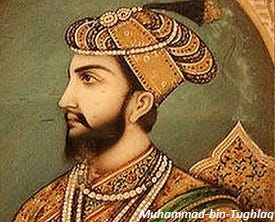Mohammed Bin Tughlaq was the last king of the Tughlaq dynasty and ruled from 1325 till his death in 1351. He ascended to the throne in Delhi. On a whim, the man decided to move the capital of his empire from Delhi to Daulatabad which is located in Maharashtra. He supposed being centrally located in India would give him greater control over the kingdom. He ordered the entire populace of Delhi to shift to the new capital in Daulatabad. Thousands died of heat exhaustion and starvation on the way from Delhi to Daulatabad.
He then set up the city from scratch, he realised that his northern borders were far more exposed to attacks and decided to move the capital back from Daulatabad to Delhi. The result was that thousands more perished and it left the empire diminished and weaker. He lost wars and he died. With the death of Mohammed bin Tughlaq, the Tughlaq dynasty also ended.

In 2014, we put the Tughlaq of our generation in power. In 2016 India underwent the most radical demonetisation that any country not suffering from uncontrollable inflation underwent. The Prime Minister came on television and announced that from 8 PM that day, all hundred rupees and five hundred rupee banknotes would no longer be valid tenders of exchange and to submit them back to the banks within a period of 2 weeks. There would be new banknotes that would be designed and issued thereafter.
Ostensibly this was done to eradicate black money. The wealth, which went undisclosed to the government to avoid taxes. 99% of the cash that the Reserve Bank of India (RBI) knew of, was collected back. If there was any ill-gotten wealth, they could not trace it.
While black money was the purported reason, rumours have it that the move was made to starve the opposition parties of cash during the 2017 UP legislative elections. The ruling BJP had not held power in the states since 2000 and came to power in 2017.
The people suffered.
Many had to stand in queues for hours to deposit their money in the bank. Most of these people were neither rich nor had any ill-gotten wealth. During those days, there would always be hundreds of people standing outside ATM machines. Queues would start forming at 7 AM. Bank employees got the worst end of the deal having to deal with the large influx of cash and their customers’ corresponding frustration and anger. The new banknote that they designed was of a different dimension and hence over 350,000 ATMs had to be reconfigured across the length and breadth of the country so they could dispense the redesigned bills.
It was a masterclass in engineering hardship.
What was utterly befuddling was the decision to issue new two thousand rupee banknotes. This would make money laundering easier. If someone had to hide cash, larger denominations made it easier to hide it. It is like the Americans deciding to solve the gun problem by taking away all the revolvers and making sure it was easier to buy machine guns.
So it came as no surprise when…
India will withdraw its highest denomination currency note from circulation, the central bank said on Friday. The 2000-rupee note, introduced into circulation in 2016, will remain legal tender but citizens have been asked to deposit or exchange these notes by Sept. 30, 2023.
Source: Reuters
Much like the shift that was made by Tughlaq was destined to fail, the introduction of the 2000 rupees note was destined to fail.
Tughlaq is what Tughlaq does.

Leave a Reply